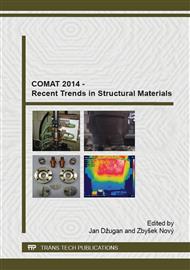p.23
p.31
p.39
p.49
p.55
p.61
p.67
p.73
p.79
Mathematical Models of Ultra-Fine Grained Materials Based on Dissipation Normal Form
Abstract:
Dissipation normal form (DNF) is a special system structure which originally came from the signal and system theory. It was derived from natural requirements of some form of an abstract energy conservation law validity. Strong nonlinearities brought into the DNF parameters can cause complex irregular oscillations of the system. Such a system is used as a generator of numerical sequencies whose properties are useful for mathematical modelling of irregularities in real fine and ultra-fine grained metal microstructures. The particular metal grains are modelled as the Gaussian curve with a 2-dimensional domain and their partial properties such as their height, width, position in the surface, elongation in a certain direction etc. can be chaotically modified. A certain part of grains can be modified separately by irregular splitting their area etc. It allows defining the individual components surface percentage to meet important statistical properties of the real material with complicated structure. In the contribution there it is shown that the presented mathematical model approximates real multiphase microstructure quite well and using DNF with strong nonlinearities represents approach with good prospects to mathematical modelling of metal microstructures including complex ones.
Info:
Periodical:
Pages:
55-60
Citation:
Online since:
October 2015
Authors:
Price:
Сopyright:
© 2015 Trans Tech Publications Ltd. All Rights Reserved
Share:
Citation:


